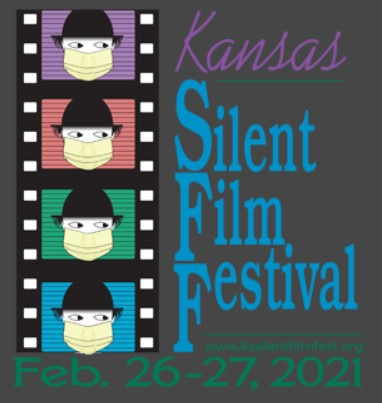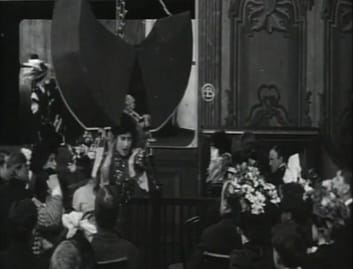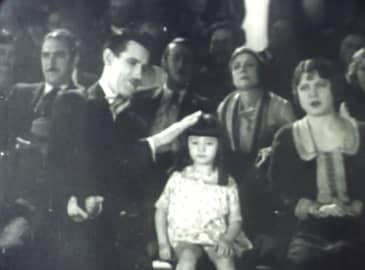
Normally held in Topeka, Kansas, the Kansas Silent Film Festival took place fully online this year. Many of the films shown over the two-day event were popular films from previous film festivals while two were screened by the wonderful Retroformat Silent Films. While they might not have as much funding or big-name restorations as the better-known international festivals, the festival had a great variety of several films that were new to me.
Being a large regional festival attended by many Midwesterners, the festival had a homegrown culture and seemed to be put on each year by a dedicated group of volunteers and organizers. I was glad to be able to catch it virtually this year over here on the West Coast safely from my living room.
To recap last weekend’s two-day festival, I’ve listed out the shorts and features shown at the 24th Kansas Silent Film Festival alongside my thoughts and pertinent screengrabs from each film.
Night 1
The first night of the festival’s theme was a night out at the movies. From a Biograph short to a British costume drama, the program had a great variety and a couple of gems.
Those Awful Hats (1908)
One of Griffith’s Biograph shorts, Those Awful Hats works as a comedic PSA reminding patrons to remove their hats before entering the theater. The film shows several women with large hats entering a Nickelodeon, blocking the screen and upsetting many of the patrons sitting behind them. In a surrealist twist, a large crane comes out of nowhere and lifts the hats off the offenders’ heads, even managing to remove one woman entirely from the theater! It’s a quirky short but shows a quite different side of Griffith’s work compared to his propensity for melodrama throughout his career. It also reminds us of the silver lining of virtual screenings: no hats.
Movie Night (1929)
Following the theme of a night at the movies, this film chronicles a visit by Charley Chase and his family to their local theater. Chase, as usual, is at the top of his game. One of his later silent two-reelers, Chase shows off his confidence and talent for situational comedy. Chase runs rampant at the theater, from trying to get a discount children’s ticket for his obviously teenage son to battling a violent bout of the hiccups in the theater. Movie Night is a fun short that made me nostalgic for the days of crowded screenings.
A Movie Star (1916)
This Keystone two-reeler features Mack Swain, best known as a prospector in Chaplin’s The Gold Rush, playing a dramatic movie star who happens upon a screening of his own film in his local theater. Swain’s movie star soaks up the attention of the movie patrons, giving over-the-top speeches thanking his fans and basking in the amount of attention his female admirers give him throughout his film’s screening. The film includes several snippets of Swain’s character’s fictional film, a melodramatic western entitled Big Hearted Jack, that adroitly parodies many of the dramas of the period.
Swain’s build and demeanor don’t fit his role as a William S. Hart-type gunslinger but that doesn’t stop him from trying his best to elevate the art of screen acting by playing for the back row. Despite his character’s over-the-top ham acting, all of the female patrons swoon over Swain, much to the disbelief and disappointment of one female fan’s beau. A Movie Star is an energetic, frantic film poking fun at the relatively new phenomenon of Hollywood stardom and allows Swain to prove his own ability to be a top-notch comedy movie star.
Nell Gwyn (1926)
A big-budget British costume drama, Nell Gwyn stars American Dorothy Gish alongside a great cast of British actors. A great international success upon its release, it features Gish as the real-life figure Nell Gwyn, a 17th-century, English comedic actress and longtime mistress of King Charles II, played wonderfully by Randle Ayrton. The film had the energy of a 30s pre-code film, focusing on the battle between Gwyn and the King’s other mistresses while featuring some of the lowest necklines in film history. The charisma of the cast keeps the film from devolving into a routine tale of royal frivolity and lasciviousness, injecting life in what could have been a tepid “who’s the king’s favorite mistress” storyline. Plus, Gish sports a hat that threatens to cover the whole screen if she ever wore it to a movie theater.
Night 2
The first two films of Saturday night were provided by Retroformat, a Los Angeles-based silent company. (To attend their wonderful monthly virtual events, visit their YouTube page here.) Both films were high-quality Al Christie comedies featuring lesser-known comedians, the first starring Billy Dooley and the second starring Dorothy Devore. The festival ended with two selections from previous Kansas silent film festivals: an Edison one-reel chase comedy and an early nature documentary of East Africa.
Sailor Beware! (1927)
Not to be confused with Laurel and Hardy’s silent comedy Sailor, Beware!, this Christie comedy features Billy Dooley as a sailor returning home after serving overseas in New Guinea. He brings home a guinea pig as a gift for his sweetheart who he finds being courted by a strong, intimidating army man. A local news headline announcing that a guinea pig with deadly germs has escaped the zoo throws the city into chaos and interferes with Billy’s plan of reuniting with his girl. Will Billy defeat his rival and win over his girl without starting a pandemic? The film obviously connects to our COVID-19 health crisis, featuring several well-protected health officials in the film’s frenetic climax. Billy Dooley’s comedy style is a bit over-the-top and while I enjoyed his humor, he might be a little bit overbearing for some.
Hold Your Breath (1924)
This Christie comedy was my favorite film from the festival. After her brother is injured at work, comedian Dorothy Devore’s character has to take over his job as a news reporter to save the family from financial ruin and her own engagement. The most fascinating thing about the film is its resemblance to Harold Lloyd’s Safety Last. The last act of the film features Devore scaling a tall building while evading police and chasing after a monkey. While the setup is slightly different from Safety Last, Hold Your Breath‘s final act is every bit as hilarious and thrilling as Lloyd’s original stunt. Devore is great throughout and is supported by a wonderful cast, including Pricilla Bonner and the ever-talented character actor Tully Marshall.
Jack the Kisser (1908)
This Edison comedy follows the formula of the popular chase comedies of the 1900s. Jack the Kisser, a play on the notorious Jack the Ripper, runs around the city kissing unsuspecting women and finds himself in a madcap chase running from the police and his female victims. While there are some moments of hilarity, such as when Jack crawls through an unfinished construction site, the film overall fails to build off the straightforward chase genre. While it is cathartic that the women get justice in his capture, there isn’t much tension or excitement in the chase itself. Even if the film didn’t deliver, it was nice to see a late 1900s Edison film since the more popular Edison fare tends to come from the 1890s or the first years of the 1900s.
Simba: King of the Beasts (1928)
Filmed over four years by the adventurer couple Martin and Osa Johnson, Simba stands as a unique, cultural document of early 20th-century colonialism in East Africa and contains rare footage of endangered Kenyan wildlife and landscape. The nature shots alone are well worth watching this film, capturing some of the earliest wildlife footage of the African Serengeti. While many have seen giraffes, elephants, and lions in more modern documentaries, seeing them in silent, black-and-white footage is an experience quite in and of itself.
Simba is obviously embellished (if not as much as the infamous documentary Ingagi), as the film’s two writers insert a seemingly fictitious and embellished account of a tribe of indigenous Africans hunting down the lion known as Simba. (One of the film’s writers was Terry Remsaye, author of the loose-with-the-facts 1925 book A Million Nights and One Nights: A History of the Motion Picture.) The indigenous peoples in the film are exoticized, portrayed as spectacles of white wonder, and primitive peoples more than happy to submissively carry around the white explorers’ gear. Also, fair warning, several animals WERE harmed in the making of the film. Despite these uncomfortable aspects of the film, it was a fascinating watch.
The festival was the perfect way to spend a few hours on the weekend enjoying a wide variety of silent films. This year, as I am told, was a bit shorter of a program than when the festival is held in-person. Next year, pandemic permitting, the festival is going all out to have a special 25th-anniversary festival. For anyone nearby or capable of traveling to Topeka, Kansas, I highly recommend attending and am hoping sometime in the future I’ll be able to make the trip myself.











